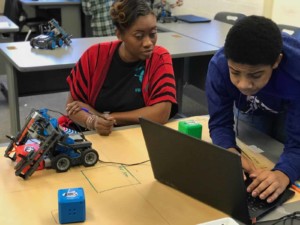School Change: Go Fast and Go Slow

By Emily Liebtag & Mary Ryerse
School change–be it a new initiative, a push for a shift in culture, or the adoption of a different teaching approach–requires both tortoises and hares. To implement change, great leaders know you need those who are going to go fast and those who remember to think about sustainability, process and go “slow”. Those sprinters will try things out, rally others to test an idea and share back what worked and what didn’t. The marathoners help us to consider everything, anticipate where there might be potholes, map out the hills to climb and plan for long-term sustainability.
Education thought leader Michael Fullan, speaks to an implementation dip that is inherent in change. One of the roles of leadership is to make the dip as short and shallow as possible. Knowing when to listen to those who are more inclined to “go slow” (establish the foundation, processes and steps to make the change work) and when to forge ahead, often driven by those who are more inclined to “go fast” (those who say ‘why can’t we start now?).
This dip is often where “things get worse before they get better.” Fullan, and many others, describe change as a process and not an event. So the slow and fast metaphor extends beyond one hare and tortoise race to an ongoing process during which different people may encourage different paces at the time.

In Fullan’s latest book (co-authored with Mark Edwards), The Power of Unstoppable Momentum: Key Drivers to Revolutionize your District, he recognizes that taking the time to cultivate key drivers will pay off. Fullan and Edwards explain:
“Because these unstoppable forces can create chaos and harm, our book is about how to corral and shape these forces for the common good — to help make unstoppably good things happens.”

The “corralling” process can be part of the slow that allows the “forces” to make things go fast. This applies not just to educators but to leaders as well. The old model, dependency on one person to lead the way and bring about change, doesn’t always work in a complex school ecosystem or in 21st-century schools where there are multiple leaders serving in not-so-traditional roles.
Roles of teacher leaders (see Teacherpreneurs from the Center for Teaching Quality for more on this idea) and school administrators are shifting as change in our school models and strategies are evolving, especially in very student-centered learning environments.
Teachers, too, must see themselves as independent, collaborative leaders who can assume a variety of leadership roles while either choosing to stay in the classroom or not. One might think that “leader,” in this sense, insinuates that these leaders need to be the sprinters and help the marathoners pick up the speed, but that isn’t the case. These leaders often have seen the most change over their tenures and are experts on what is going on in the classroom, putting them in the prime seat to understand how to drive change. As Dr. Megan Allen, current National Network of State Teachers of the Year employee and former Mt. Holyoke Director of Teacher Leadership states, “We’ve got to be smarter than that, and let our teachers, our experts lead the charge.”
Peter Senge captures it well in The Leader’s New Work: Building Learning Organizations.
“Our traditional view of leaders — as special people who set the direction, make the key decisions, and energize the troops — is deeply rooted in an individualistic and nonsystemic worldview. Especially in the West, leaders are heroes — great men (and occasionally women) who rise to the fore in times of crisis. So long as such myths prevail, they reinforce a focus on short-term events and charismatic heroes rather than on systemic forces and collective learning.
Leadership in learning organizations centers on subtler and ultimately more important work. In a learning organization, leaders’ roles differ dramatically from that of the charismatic decision maker. Leaders are designers, teachers, and stewards. These roles require new skills: the ability to build shared vision, to bring to the surface and challenge prevailing mental models, and to foster more systemic patterns of thinking. In short, leaders in learning organizations are responsible for building organizations where people are continually expanding their capabilities to shape their future — that is, leaders are responsible for learning.”

In Originals, Adam Grant shares a similar idea. He writes, “I want to debunk the myth that originality requires extreme risk-taking and persuade you that originals are actually far more ordinary than we realize.” Amongst stories and research about how to champion new ideas and fight groupthink, Grant also shares that those who procrastinate (wait to take on a new idea or share their own original thought) often can be the ones who end up making the most traction and seeing the most success. Another notable author, Nobel Prize winner Daniel Kahneman, has researched the science behind thinking fast and slow and finds that there are times when both are beneficial.
So how does this all apply to school change?
Schools are complex ecosystems and a top-down, one-size-fits-all approach to implementing a new idea or initiative does not have the best track record. You need sprinters and marathon runners to bring about progress and implement sustainable change. As Peter Senge proclaims, you need creative tension between where you are, where you want to be and what the common vision is that you are striving for.
If you are embarking on some type of change at your school or in your district this year, be sure to listen to your sprinters and your marathoners — appreciate all of the voices and paces at the table.
For more, see:
- Getting Smart Podcast | Acton Academy: Building a Student-Centered School…And Global Network
- Using Student Feedback to (Actually) Drive Change
- The 5 Pillars of Whole School Transformation
Stay in-the-know with all things EdTech and innovations in learning by signing up to receive the weekly Smart Update.







Mohammed Salah
Wonderful thoughts! You rightly pointed out that the role of leadership is to make the implementation dip as shallow and short as possible. Found a nicely written article on Beating the Implementation Dip (http://academy.whatfix.com/implementation-dip-change-management) which points out that the right training and right amount of hand holding during this dip can pull people through.